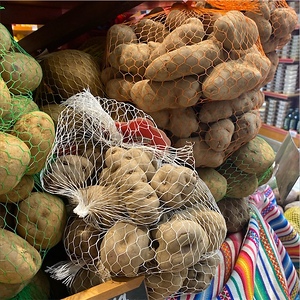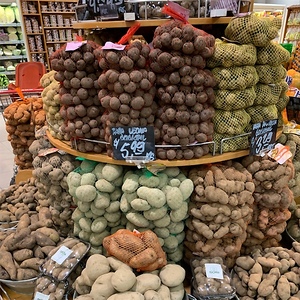


Leona Potatoes
Estimated Inventory, lb : 0
Description/Taste
Leona potatoes vary in size, coloring, and shape, as several types are generally categorized under the Leona name. The tubers average 6 to 8 centimeters in length and 5 to 6.5 centimeters in diameter and range from round, oblong, to irregular in shape. Some tubers are more misshapen than others, and the differences in form are primarily created from the depth of eyes found across the surface. Leona potatoes vary from having shallow, superficial eyes to deep-set eyes, and the skin is generally taut, textured, and semi-smooth with spots and markings. The potatoes are often sold in markets still covered in soil, giving the tubers a muted grey-brown coloring. Once washed, the skin varies in color from dark red-purple, pale red-purple, to purple-black with cream-colored to yellow eyes. Underneath the surface, the flesh can be a solid dark purple or cream-colored with violet-maroon mottling and vascular rings. The flesh is dense, hard, and slippery when raw, with a drier and starchy content. After cooking, the flesh develops a soft, tender, but still semi-firm consistency and has a thick, floury texture. Leona potatoes are not edible raw and should be cooked, showcasing a mild, earthy, and slightly nutty taste.
Seasons/Availability
Leona potatoes are available year-round.
Current Facts
Leona potatoes, botanically classified as Solanum tuberosum, are a South American variety belonging to the Solanaceae or nightshade family. The name Leona roughly translates from Spanish to mean “lioness” and is a type of native potato, or papa nativa, traditionally grown at high elevations in the Andes Mountains. Several types of Leona potatoes are found in local markets throughout Peru and Ecuador, and each type varies in coloring. The main types of Leona potatoes include Leona Blanca, Leona Negra, Leona del Carchi, and Leona Roja. Leona potato plants produce approximately 20 to 31 tubers per plant and are favored for their pigmented nature, believed to provide beneficial nutrients. Historically, Leona potatoes were a native variety localized to the Andes as a traditional crop, but the variety was eventually selected as a native tuber to commercially promote in modern markets. Despite being commercially pushed, Leona potatoes are still relatively challenging to find and are viewed as a specialty variety utilized in savory, cooked preparations.
Nutritional Value
Leona potatoes have not been extensively studied for their nutritional properties. The tubers are mainly known for their purple-hued flesh, which is believed to contain anthocyanins or natural pigments. Anthocyanins have anti-inflammatory, antimicrobial, and antioxidant-like properties that protect cells against damage caused by free radicals and oxidative stress. Potatoes, in general, contain potassium to balance fluid levels within the body, iron to develop the protein hemoglobin for oxygen transport through the bloodstream, and fiber to regulate the digestive tract. Potatoes also provide vitamin C to strengthen the immune system, copper to produce red blood cells, calcium to protect bones and teeth, and other nutrients, including manganese, vitamin B6, and zinc.
Applications
Leona potatoes have a subtly sweet, earthy, and neutral taste suited for cooked preparations. The variety is considered more of a gourmet variety in South American markets and is traditionally boiled, roasted, and fried. Leona potatoes can be served as a simple side dish to roasted meats or cooked and stuffed with cheese and other fillings. The tubers can also be simmered into soups, stews, and chowders, boiled and mashed, or pureed and spread as a thick base for plates. In the Andes, Leona potatoes can be cooked in outdoor oven preparations, including hautia and pachamanca, or they are sliced and fried into colorful chips. The tubers can also be boiled and tossed into potato salads or mashed into a colorful dish. Leona potatoes pair well with herbs such as oregano, thyme, cilantro, and mint, hardboiled eggs, meats such as beef, pork, and poultry, corn, carrots, legumes, and avocado. Whole, unwashed Leona potatoes will keep for several weeks when stored in a cool and dry location.
Ethnic/Cultural Info
In Ecuador, Leona potatoes are one of twenty varieties commercially grown in the country. Over four hundred types of potatoes are found throughout Ecuador, and Leona was selected as a native, commercial variety for its pigmented skin and flesh coloring. Despite potatoes being a traditional ingredient, many of the native varieties have faded from the public eye as most consumers are only exposed to a few types in modern markets. In the 21st century, there has been a movement to promote diversity among potatoes throughout South America by establishing National Potato Day. This annual celebration was developed through a partnership between the International Potato Center, the Food and Agriculture Organization of the United Nations, and the National Institute of Agricultural Research and was launched in 2008. National Potato Day is held at the end of June and was strategically scheduled to overlap with the potato harvest. During the celebration, various markets showcase local varieties of potatoes, and growers from the Andes region travel to cities to attend potato exhibitions. Field days are also held to promote new advancements in potato breeding, and biodiversity seed fairs allow growers to trade native varieties. National Potato Day has helped generate awareness around the unique cultivars native to the Andes, and events in Ecuador have contributed to the Leona variety’s success as a specialty tuber.
Geography/History
Leona potatoes are native to South America and are descendants of wild varieties that grew naturally throughout the highlands of the Andes mountains. Much of the history of Leona potatoes is unknown, as little written records were left before the arrival of the Spanish, but it is believed they are one of the traditional cultivars called native potatoes within the communities of the Andes. Leona potatoes are typically grown between 3,000 and 3,500 meters in elevation and are thought to have been popularized in markets within Ecuador. The variety has also been cultivated in regions of Peru and is considered a native variety in both countries. Today, Leona potatoes are grown in the departments of Huancavelica, Ayacucho, and Apurimac in Peru and in Carchi, Cotopaxi, and Chimborazo in Ecuador. The tubers are sold throughout their growing regions and are also transported to commercial markets in other cities for culinary use. The Leona potatoes featured in the photograph above were sourced through markets in the districts of Miraflores and Surquillo in Lima, Peru.
Recipe Ideas
Recipes that include Leona Potatoes. One









